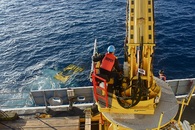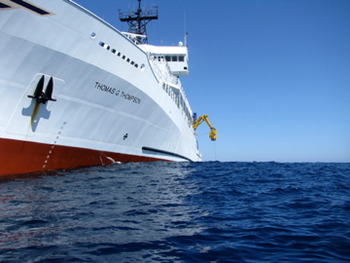Matthew Knight
Some final remarks
Wednesday, August 31, 2011
We’ve finished our work at Axial Seamount and are headed back to land today. The whole time we have been transiting back though our ship has been in the trough, meaning the side of our ship is being buffeted by waves moving perpendicular to us. These conditions have truly given me a new appreciation for the old phrase “getting your sealegs”. We literally can’t walk anywhere on this ship now without timing the rising and falling of the floor beneath us (otherwise you suddenly end up running downhill with expensive electronics or coffee in your hand).
From a scientific standpoint this has been an overwhelmingly successful trip. We had a science meeting last night to review what we had completed, and the list grew pretty quickly. People described either their personal research successes or the incredible public outreach that was done by making all of our activities on board this ship open to the Internet. I for one grew to appreciate the outreach aspect of this project the other day while kids at the Northwest Pacific Science Center typed questions to us while we were streaming live HD video from the seafloor. A surprising number of the questions asked about all of our backgrounds and just how exactly someone gets onto an oceanography research cruise. I had never thought until then that what I’m doing, and the classes that I take during the school year, could be fascinating to somebody who is still trying to decide what they’re interested in. These kids were fairly young I’m sure, but it is still an exciting concept to think that maybe we sparked an interest in oceanography in even just a few of them.
Wrapping up the weekend
Sunday, August 28, 2011
It’s been a fun past couple of days on our little floating island out here. On Friday the resident film crew wanted to take out the zodiac so they could film the recovery of ROPOS back onto the ship’s deck. They had spare room and were able to take me and two other undergrads, Martha and Cody, along for the ride. I’ve been on two other cruises on the Thompson before but I’ve never had quite the appreciation for the impressive size and beauty of this ship until I was looking up at it from water level. The true icing on the cake though was that it was about 80 degrees and sunny yesterday too so we might as well have been out on the Caribbean, not in the North Pacific. Also, instead of having dinner inside last night we had a barbeque out on the back deck with all of the crew. There’s nothing quite like a burger 300 miles away from any land.
In terms of real work, Dr. Bob, myself, and a few others have been working away at our water samples and beginning to really be able to put together a story about the microbial critters living out here. We have somewhat of an expedited work schedule in the sense that I have to be able to present a short piece on Wednesday about the research that I have been doing out here (along with all of the other undergrads). I’ll be able to talk about our sampling locations, some of the cell count data and chlorophyll measurements we’ve gathered to try and quantify the microbes living out here. Unfortunately though, we will have to wait until we are back on shore in order to do some of the really interesting experiments. These experiments will include a DNA analysis called T-RFLP (Terminal Restriction Fragment Length Polymorphism) that will help us classify the bacterial groups that are present in our samples.

Das Boot
Wednesday, August 24, 2011
After having a few shifts in the ROV room, which is quite the experience, I can honestly say that watching these guys operate their sub is slightly hilarious. The other night they were sitting in the dark control room, navigating and steering the thing along as if what they are doing is no different than driving a golf cart. Then in a nonchalant yet polite way (these guys are very Canadian and very polite), one of the pilots explained to me that he was part of the core group that both designed and built this multi-million dollar monster. And this sub is cool, really cool. Its main HD camera is a bulbous orb larger than the size of my head, and it even has a couple back up cameras pointing in various directions. It has two extendable, articulated arms with claws for grabbing samples, and the claws have force-feedback functionality. That means that when the operator is using one of the arms to grab a rock, he can actually feel it on his control board when the claw touches the rock. ROPOS also has a slurp gun for grabbing your more watery samples and a number of sampling boxes for holding rocks. The sub has more propellers and jets on it than our ship I believe, oh, and it has its very own custom-made crane for going in and out of the water.
My official part in the ROPOS operations is to be the HD camera operator. That means that during my shift I control the iris of the camera to make sure that the right amount of light enters the camera so that the video streaming back to shore is viewable. However, last night when my shift started (at midnight), the ROPOS crew had just begun pulling the sub back up to the deck for some maintenance work. So instead of working the camera we worked on unloading the rock and water samples that had been collected over the course of the day. These samples were collected in a very expensive and laborious way, sending a deep water ROV thousands of meters down in the ocean to get them, so there’s no way I can truly explain how privileged I felt to be part of the group processing them. After three years of science and oceanography courses and seeing pictures of people doing this sort of work, suddenly I got to be the guy doing it.
Oh also, I sighted an Albatross from the ship’s bridge today. It was great but don’t ask me what kind of Albatross it was.

A few less-than-scientific findings
Monday, August 22, 2011
We’re five days into what has been an amazing trip. There’s nothing quite like being on a world-class oceanographic research vessel which also just happens to be carrying along with it a 7 foot tall submersible ROV with its own crane and operating crew. The ROPOS ROV is an incredible piece of technology and understandably is often the center of attention. But we’ve all also been hard at work initiating our own little projects, for me that means that I have been collecting and processing a number of water samples that were gathered from as deep as 3000 meters and taking part in my watch in the ROV control room where I get to control the sub’s main HD camera which has a price tag of about $180,000. No big deal.
In addition to the official work however, I have also made a few non-scientific findings about life aboard the R/V Thompson that they don’t teach in any class. I would like to now share a few these:
1) Eating lots of meatloaf right before leaving port for an all-night transit out to open ocean is a BAD idea.
2) My room is right next to the bow thruster. Actually, my room might as well be the bow thruster room.
3) Earplugs do not exactly block the sounds from the bow thruster room.
4) One of my professors really likes the Black Album by Jay-Z (I don’t want to name any names but he goes by “Dr.” Bob Morris).
Long story short, an interesting dynamic emerges from working side-by-side with my fellow students and scientists 24/7 in a relatively confined area. This cruise is one of those rare opportunities where we students simultaneously get to know our teachers really well and learn a great deal from them about how ocean research is conducted. We have been having a lot of fun while we’re at it, but I really cannot stress enough how much I regretted that meatloaf.
Axial Seamount and Microbiology
Thursday, August 18, 2011
Hi, I’m Matt Knight, I’m a senior in my undergraduate studies at UW, and this is my first blog post for the upcoming Visions 2011 research cruise, leg #2. I will be boarding the R/V Tommy Thompson tomorrow in Newport, Oregon with my fellow undergraduates, some graduate students, professors, engineers, and one really big robot. The ship will then head towards Axial Seamount, an underwater volcano and vent system sitting on top of the Juan de Fuca Ridge, and a site of interest in the soon-to-be-constructed Regional Scale Nodes cabled observatory network. The basic idea of the project is that the best way to study an underwater volcano (and the oceans) is to permanently install instruments on the seafloor and connect them to the Internet so that data can be continuously streamed back to shore to the joy of marine scientists and (hopefully) the general public. The primary goals of this cruise is to survey and map the region around Axial so that we can know where exactly to install our instruments when it comes time.
My research on this cruise is going to be primarily focused on the microbiology of the waters around Axial Seamount. Because this particular area in the Pacific Ocean is going to the be the destination of many future research cruises, the Visions cruise will offer us the opportunity to begin a time series of data collection on the bacterial communities in the area. In much the same that the Keeling curve (the graph showing increasing CO2 concentrations in our atmosphere) was created by collecting many decades worth of CO2 concentrations in one spot, we hope to be able to eventually look at years’ worth of data on bacteria around Axial. For me personally, this means that I will be taking water samples and doing cell counts for bacterial abundance, and dilution experiments that will allow us to isolate certain bacteria for later culturing and species-level classification work.


